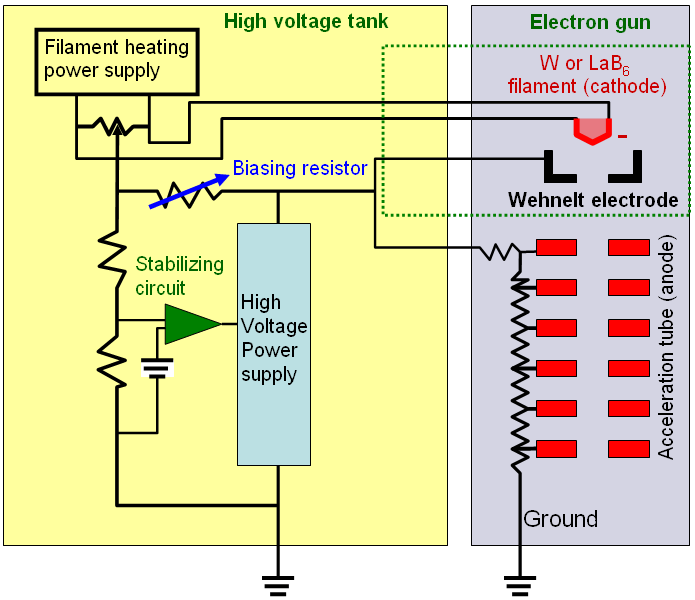=================================================================================
Before the application of field emission electron guns in TEM, the energy resolution of EELS systems had been ~1–2 eV, mainly limited by the energy spreading of thermionic electron source (tungsten filament or LaB6(lanthanum hexaboride)). In the late 1990s, Schottky emission sources became available and have been providing energy resolution greater than 0.5 eV. Note that LaB6 and W (tungsten) electron guns normally provides incoherent electron rays. Figure 3930 shows the schematic illustration of the electric circuit of thermionic electron guns with tungsten and LaB6 filaments. The main part which is different from thermal FEG is dash-green-boxed.

Figure 3930. Schematic illustration of the electric circuit of thermionic electron guns with tungsten and LaB 6 filaments. In EMs, the condenser aperture is used to exclude electrons emitted at high angles from the electron gun, which will decrease the brightness but improve the quality of the illumination because these peripheral electrons are less coherent, especially in LaB6 and W (tungsten) guns. Furthermore, a table on the comparison of various electron sources in page1409 indicates that the LaB6 guns should be used under a higher vacuum than the tungsten guns, and the LaB6 guns provide higher brightness, smaller electron source, and smaller energy spread. Therefore, the LaB6 guns are more suitable for analytical electron microscopes than the tungsten guns.
In images formed by elastic scattering (e.g. HRTEM images), contrast delocalization is referred to as the loss of image contrast due to lens aberrations or called blurring effect. In this case, the image information is blurred and displaced from their true locations in the TEM specimen. In other words, the contrast delocalization can also be expressed as the lateral displacement of spatial frequencies in the image. This displacement increases with spatial frequency significantly. It is rarely a problem on the microscopes with LaB6 guns due to their limited coherence in illumination. However, it is a significant imaging artifact in HRTEM images taken from microscopes with field emission guns (FEGs) due to their high coherence that causes a strong contribution of the high spatial frequencies.
Both ion getter pumps and cryo-pumps are often employed in applications requiring extremely clean, ultrahigh vacuums, e.g. in LaB6 guns and FEGs.
|
